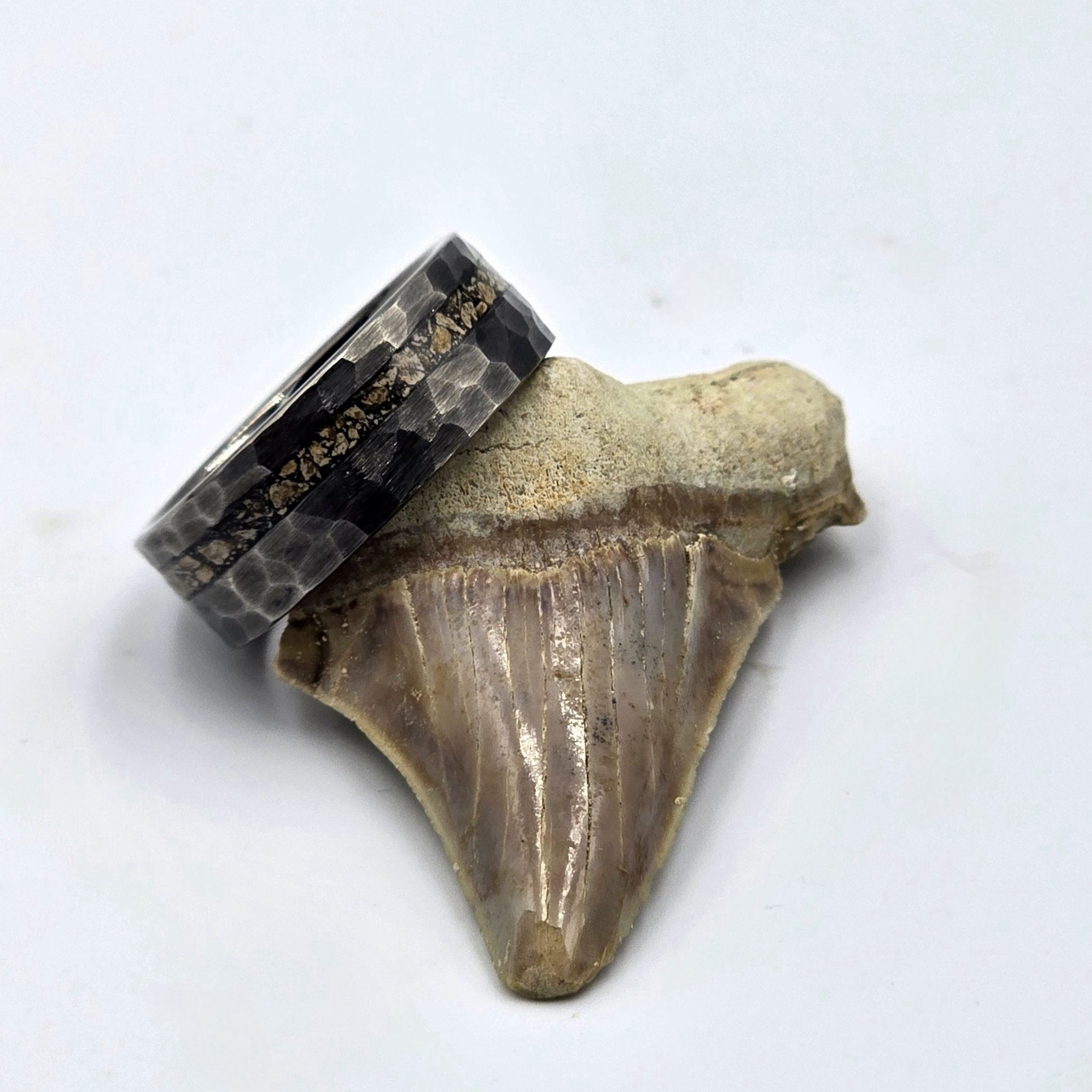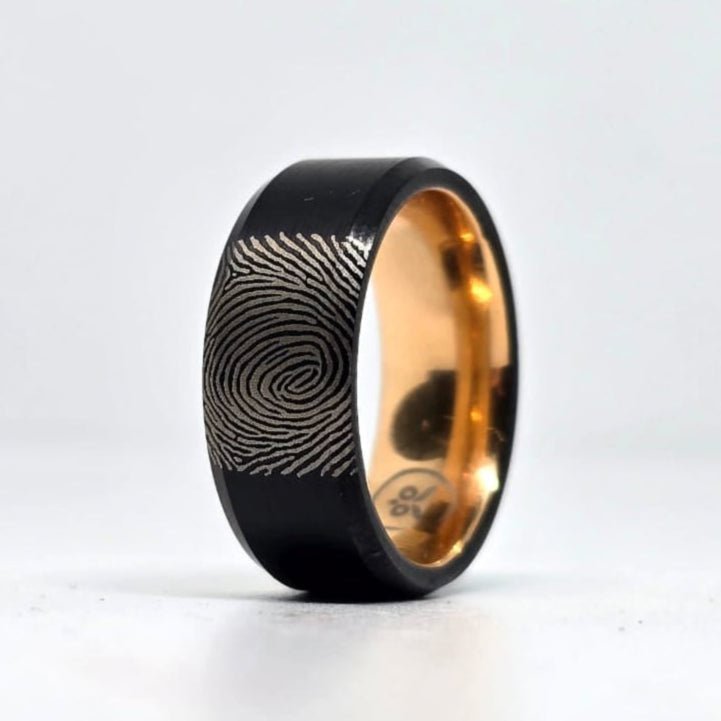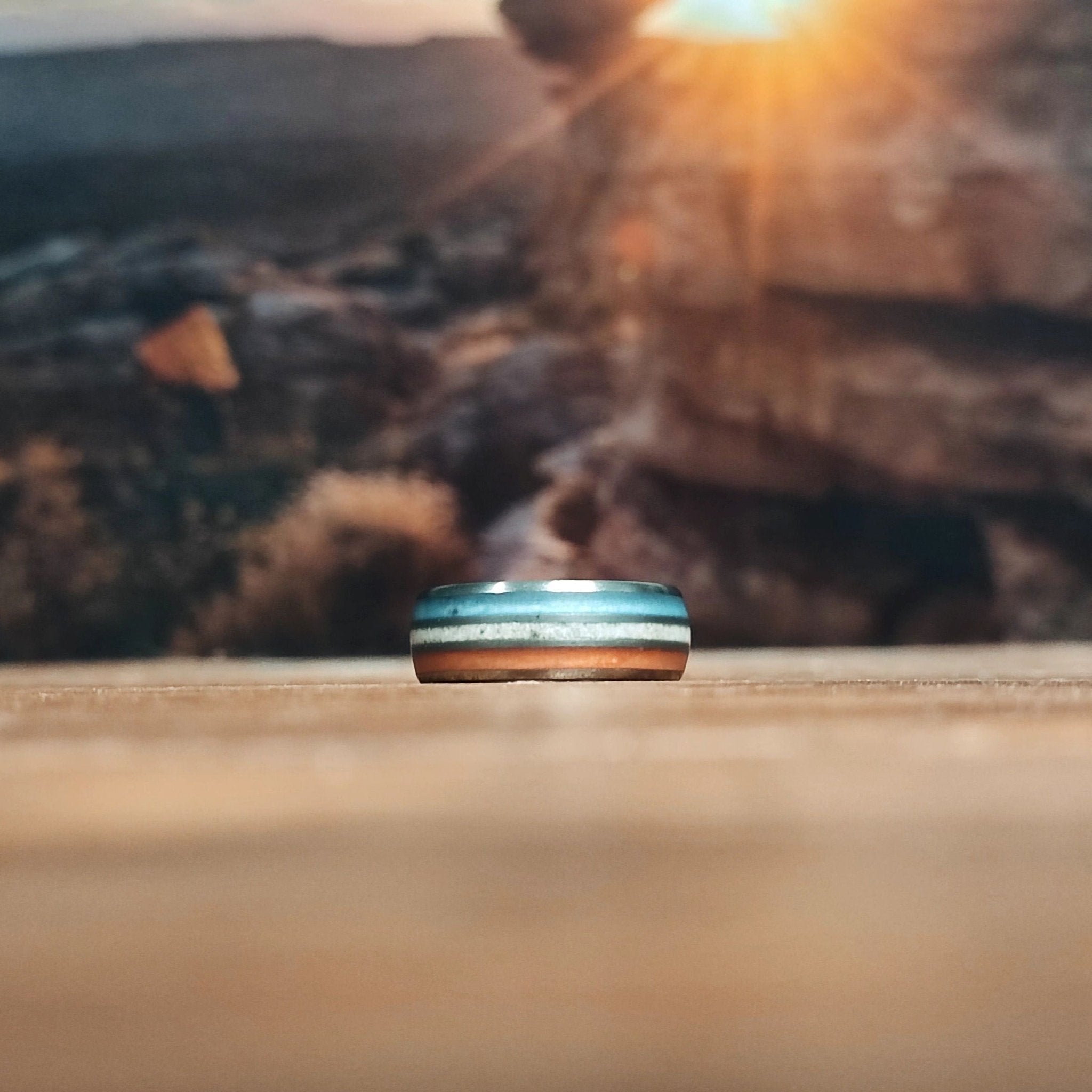
Jaws - Megalodon Tooth Set in Dim Grey: Wear a Piece of Prehistoric Power
What if you could hold a time capsule from an age when giants ruled the planet? Not in a museum display case, but on your person, a constant and tangible reminder of the Earth’s incredible history. Imagine carrying the power of the largest shark that ever lived, not as a mere concept, but as a wearable piece of natural history. This is the promise and the presence of the Otodus Obliquus Megalodon Tooth Fossil Ring. More than an accessory, this ring is a statement—a direct link to the primal forces of the prehistoric oceans, masterfully encased in modern, rugged craftsmanship. In the following sections, we will embark on a journey through deep time, exploring the legacy of the apex predator whose tooth you can own, the artistry behind its setting, and the undeniable presence it commands. See more custom rings here.
The Apex Predator of the Ancient Seas: Meet Otodus obliquus
Long before the legendary C. megalodon terrorized the Miocene oceans, its formidable ancestor, Otodus obliquus, was the master of the deep. This colossal shark patrolled the warm, fertile waters of the Paleocene and Eocene epochs, a period spanning from 65 to 40 million years ago. To put that timeline into perspective, this was the era just after the cataclysm that wiped out the dinosaurs, a world where mammals were beginning their ascent and the oceans were ripe for a new ruler.
Otodus obliquus was that ruler. Scientists estimate this prehistoric shark reached staggering lengths of 30 to 40 feet, making it a true apex predator of its time. Its name, derived from Greek and Latin, hints at its nature, with "Otodus" meaning "ear-shaped tooth," a reference to the distinctive curvature of its dentition. As a key figure in the evolutionary chain of megatoothed sharks, Otodus obliquus is the crucial missing link, the direct progenitor of the line that would eventually produce the infamous Megalodon. Owning a fossil from this creature is not just owning a tooth; it's owning a piece of evolutionary history.
From Moroccan Depths to Your Finger: The Fossil's Journey
Every relic has an origin story, and the Otodus obliquus tooth in your ring has one of the most dramatic on Earth. Its journey begins in the phosphate-rich deposits of Khouribga, Morocco. This region was once a shallow sea teeming with marine life, a perfect hunting ground for the massive shark. Over millions of years, sediment, minerals, and the bones and teeth of countless creatures accumulated on the seafloor, fossilizing under immense pressure and becoming encapsulated in the phosphate rock.
Today, the vast plateaus of Khouribga are home to some of the world's most prolific phosphate mines. It is here that skilled miners and fossil preparators carefully extract these ancient treasures. The process is meticulous, often involving hand tools to painstakingly free the fragile fossils from the surrounding matrix without damaging them. This isn't a process of mass production; it's one of recovery and preservation. Each tooth is a genuine artifact, certified by its origin, ensuring that the centerpiece of your ring is a unique, 40-million-year-old relic of a bygone world.
Anatomy of a Killer: Decoding the Megalodon Tooth
The sheer size of the fossil is the first thing that commands attention. At 47mm by 46mm, this tooth is larger than the palm of most adult hands—a visceral indicator of the sheer scale of the animal it came from. But its power lies not just in its size, but in its sophisticated biological engineering, perfectly adapted for a life of predation.
Let's break down the key features that made this tooth a perfect killing tool:
-
Serrated Edges: Run your finger (carefully!) along the edge of the fossil. You can feel the tiny, razor-sharp serrations. These functioned like a natural steak knife, allowing Otodus obliquus to efficiently slice through the thick flesh and blubber of its prey, which included ancient whales and other large marine mammals. This design is a hallmark of an efficient macropredator.
-
Robust Structure and Lateral Cusplets: The tooth is not a flat blade; it is a robust, thick structure built to withstand immense force. Flanking the main crown are the distinct, hook-like lateral cusplets. Paleontologists believe these acted as grippers, helping to secure struggling, massive prey during an attack, preventing escape and ensuring a fatal hold.
-
The Bourrelet: A key identifying feature of Otodus teeth is the bourrelet—a smooth, thickened band of enamel at the base of the tooth, just above the root. This wasn't merely decorative; it added critical structural integrity to the tooth, reinforcing it against the tremendous stresses of biting down on large, powerful animals.
This combination of slicing, gripping, and strength is a masterclass in evolutionary design, a testament to the shark's reign at the top of the food chain.
The Evolutionary Lineage: From Obliquus to the Legendary Megalodon
To understand the significance of Otodus obliquus is to see it not as a standalone species, but as the foundational chapter in an epic saga. It is the direct ancestor in the lineage that culminated in the legendary Carcharocles megalodon, the shark that has captivated our imaginations for generations.
The evolutionary path is a fascinating one, traceable largely through the fossilized teeth these creatures left behind. The journey begins with Otodus obliquus in the Paleocene. As millions of years passed, its descendants evolved, with their teeth undergoing subtle but significant changes. Otodus obliquus gave way to species like Carcharocles chubutensis, which displayed even larger teeth with slightly reduced cusplets. Finally, from this line emerged C. megalodon, with its iconic, massive teeth and virtually non-existent cusplets, representing the pinnacle of this predatory design.
Therefore, when you hold an O. obliquus tooth, you are holding the prototype, the original blueprint from which the ultimate oceanic super-predator was refined. It is the genesis of the Megalodon legend.
A Statement in Metal: The Art of the Gunmetal Tungsten Setting
To house such a powerful relic requires a setting of equal strength and character. For this, we turn to modern materials and masterful design, choosing Brushed Gunmetal Tungsten as the perfect complement to the ancient fossil.
Tungsten carbide is renowned in the world of men's jewelry for its exceptional properties. It is incredibly durable, highly resistant to scratches, and maintains its finish for a lifetime, ensuring the ring's setting looks as commanding decades from now as it does today. The "Dim Grey" or Brushed Gunmetal finish is a conscious aesthetic choice. This dark, muted, non-reflective grey evokes a sense of industrial strength, modern armor, and stealth. It doesn't shout; it commands quiet attention.
Enhancing this aesthetic is the hammered texture applied to the tungsten. This industrial, tactile surface creates a beautiful play of light and shadow, perfectly mirroring the raw, organic, and time-worn texture of the fossil itself. The ring is a bold 8mm wide, a width that speaks to its powerful presence, yet it is crafted with a "Comfort Fit" design, meaning the interior is gently domed to make it surprisingly easy to wear all day, every day.
Where Prehistory Meets Modern Engineering: The Crafting Process
Creating a ring of this nature is not a simple assembly line task. It is a custom, made-to-order process that requires patience, precision, and a deep respect for the ancient material at its heart. The primary challenge lies in setting a 40-million-year-old, inherently fragile fossil into a rigid metal band without compromising its integrity.
This is where the protective epoxy dome becomes a non-negotiable feature of the design. After the tooth is meticulously secured within the gunmetal tungsten setting, a crystal-clear, medical-grade epoxy resin is carefully applied over it. This resin is then polished to a smooth, comfortable finish. This process serves several critical functions:
-
Protection: It creates a waterproof, shock-absorbent seal that shields the fossil from moisture, impacts, and the daily wear-and-tear of life on a finger.
-
Security: It permanently locks the tooth in place, ensuring it cannot become loose or fall out.
-
Comfort: It provides a smooth surface against your skin, making the ring practical for continuous wear.
Due to the size and quality required, only a limited number of rings can be crafted from a single, pristine Otodus obliquus tooth. This inherent scarcity makes each ring a exceptionally rare possession.
Beyond Jewelry: The Ring as a Conversation Starter
This ring does not blend into the background. It is a piece that is felt as much as it is seen, and it invariably sparks curiosity. Wearing it is an invitation to tell a story—a story of deep time, evolutionary marvels, and ancient oceans.
For the wearer, it can serve as a powerful personal symbol. It can represent:
-
Resilience and Power: A connection to the ultimate survivor, an apex predator that ruled for millions of years.
-
A Passion for History and Science: A demonstration of an interest in paleontology, geology, and the natural world.
-
Unique Style: A definitive statement against conventional jewelry, showcasing a taste for the unconventional and the meaningful.
It appeals to the collector, the history buff, the innovator, and anyone who seeks to wear something with a profound and authentic narrative.
Styling the Primordial: How to Wear Your Megalodon Ring
A piece with this much inherent presence requires a confident approach to styling. The goal is to let it shine as the focal point it was designed to be.
Actionable Styling Tips:
-
The Solo Statement: The most powerful way to wear this ring is alone. Let it occupy a single finger, preferably on your dominant hand, where its scale and detail can be fully appreciated without competition.
-
Complementary Pairings: If you prefer to layer your jewelry, pair it with pieces that share its aesthetic. Think matte black or gunmetal watches, dark leather bracelets, or simple, heavy-band rings in similar tones. The key is to choose accessories that complement its rugged, industrial feel without distracting from the main attraction.
-
Occasion-Based Wearing: This ring is perfectly suited for casual outings, creative workplaces, weekends, or any event where personal expression is valued. It's a piece that speaks of confidence and a connection to something timeless.
Caring for Your Prehistoric Relic: Maintenance and Longevity
While the ring is built for durability, proper care will ensure it remains a centerpiece of your collection for a lifetime. The good news is that maintenance is straightforward.
Practical Care Instructions:
-
Cleaning: Use a simple solution of warm water and a mild dish soap. Gently scrub the ring with a soft-bristled toothbrush to remove dirt and oils from the textured tungsten and around the epoxy dome. Rinse thoroughly and dry with a soft, lint-free cloth.
-
What to Avoid: Despite being waterproof, avoid exposing the ring to harsh chemicals like chlorine, bleach, or abrasive cleaners. Do not use ultrasonic jewelry cleaners, as the high-frequency vibrations could, in theory, affect the ancient fossil over time.
-
Storage: When not being worn, store the ring separately in a soft pouch or a dedicated compartment in your jewelry box. This will prevent the tungsten from scratching other, softer metals and protect the epoxy surface.
The epoxy sealant is designed to be permanent and durable, ensuring the fossil within is protected for generations under normal wear conditions.
A Limited Offering in Deep Time: The Urgency of Ownership
It is crucial to recognize that the centerpiece of this ring is a non-renewable resource. The fossilized teeth of Otodus obliquus are not being created; they are only being discovered, and with each discovery, the available supply diminishes. The mines of Morocco are finite, and finding teeth of this size, quality, and integrity is becoming increasingly rare.
This ring represents a unique convergence: a fossil of significant scientific and historical importance, masterfully set in a modern, heirloom-quality band. It is more than a purchase; it is an acquisition of a piece of the planet's most dramatic history. It is an heirloom in the making, a piece that holds a story far grander than any gemstone, a story that began 40 million years ago. This is your chance to claim that story and wear it as a part of your own.
Conclusion: Secure Your Piece of Prehistoric Power
The journey of the Otodus Obliquus Megalodon Tooth Fossil Ring is a bridge across epochs—from the primal seas of the Eocene, through the mineral-rich depths of Morocco, to the skilled hands of modern craftsmen. It is a singular object that encapsulates raw, ancient power within a shell of sleek, contemporary strength. This ring is a testament to the giants that once were and a bold statement of individuality for the wearer who dares to command such presence. Don't let this chapter of prehistory remain a closed book. Confirm your ring size, and take the step to secure a tangible piece of the legendary Megalodon lineage. Own the power. Wear the history.



